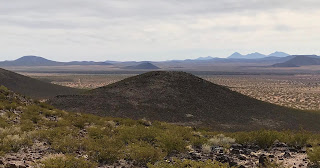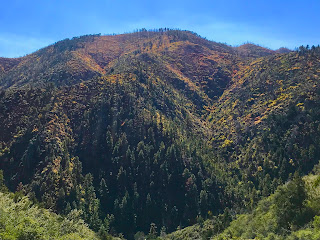Slot Canyon Access Saga
Back in May someone starting putting NO TRESPASSING signs on the gate where most folks access the popular Slot Canyon hike. While most of the Slot Canyon itself is on BLM land, I wasn't totally sure to whom the land closest to NM 185 belonged. Years ago there had been a small sign indicating it was the property of New Mexico State Parks. The sign is gone now.
I had some concern that the parcel of land had changed hands. Some research turned up that the land had once been owned by the Trust for Public Land, but I couldn't get a response from that organization, so I was still unsure. Earlier this month, someone had reported on my Facebook page for our book Exploring Organ Mountains Desert Peaks National Monument, that there was now some sort of substance on the gate that caused burning and irritation if touched.
I found this new wrinkle more than just annoying and began contacting the State Police, the State Land Commissioner's Office, and the Doña Ana County Sheriff. I also went to our county tax assessors and determined definitively that the gate was on a 664 acre parcel that belongs to . . . State of New Mexico Energy, Minerals and Natural Resources of which NM State Parks is a department. They are the ones who purchased the land in 2009, along with the Broad Canyon Ranch directly across the road.
I contacted Patrick Nolan of Friends of the OMDPNM right after first discovering the signs. He then went to work not only periodically removing the signs ( which always went back up), but also, believing the gate was on New Mexico State Trust lands( the State Lands are directly adjacent to the State Parks parcel and this mistake could be easily made), he negotiated a recreation easement with them. Two weeks ago we took a student crew( as well the man who originally did the survey for the state when they acquired the land) from NMSU to survey a definitive trail route, which is being required by our State Lands commissioner's office. We also hacked off the NO TRESPASSING sign which had now been secured with a heavier wire.There is an application and a three thousand dollar fee ( $100 a year for 30 years) to be dealt with in the coming weeks. This initial survey didn't quite work as the equipment in use that morning required a continuous cell signal, but we will be back to complete it in the very near future.
State Parks has also contacted me and assured that they are not the ones posting the signs and that they will be meeting with the BLM soon to hopefully workout access through their property as well. Wheels grind slowly, but they are in motion and hopefully the person who foolishly tried to discourage people from visiting their public lands will cease and desist before law enforcement has to get involved. In the meantime please feel free to climb over the gate and do the hike as people have done for years now. We were glad to see several young families visiting the morning of the 16th who were happy to be photographed for the Friends of the OMDPNM Facebook page which we also hope will discourage the sign posting individual when they see the faces of real people who are potentially being affected by their negative actions.
I had some concern that the parcel of land had changed hands. Some research turned up that the land had once been owned by the Trust for Public Land, but I couldn't get a response from that organization, so I was still unsure. Earlier this month, someone had reported on my Facebook page for our book Exploring Organ Mountains Desert Peaks National Monument, that there was now some sort of substance on the gate that caused burning and irritation if touched.
I found this new wrinkle more than just annoying and began contacting the State Police, the State Land Commissioner's Office, and the Doña Ana County Sheriff. I also went to our county tax assessors and determined definitively that the gate was on a 664 acre parcel that belongs to . . . State of New Mexico Energy, Minerals and Natural Resources of which NM State Parks is a department. They are the ones who purchased the land in 2009, along with the Broad Canyon Ranch directly across the road.
I contacted Patrick Nolan of Friends of the OMDPNM right after first discovering the signs. He then went to work not only periodically removing the signs ( which always went back up), but also, believing the gate was on New Mexico State Trust lands( the State Lands are directly adjacent to the State Parks parcel and this mistake could be easily made), he negotiated a recreation easement with them. Two weeks ago we took a student crew( as well the man who originally did the survey for the state when they acquired the land) from NMSU to survey a definitive trail route, which is being required by our State Lands commissioner's office. We also hacked off the NO TRESPASSING sign which had now been secured with a heavier wire.There is an application and a three thousand dollar fee ( $100 a year for 30 years) to be dealt with in the coming weeks. This initial survey didn't quite work as the equipment in use that morning required a continuous cell signal, but we will be back to complete it in the very near future.
State Parks has also contacted me and assured that they are not the ones posting the signs and that they will be meeting with the BLM soon to hopefully workout access through their property as well. Wheels grind slowly, but they are in motion and hopefully the person who foolishly tried to discourage people from visiting their public lands will cease and desist before law enforcement has to get involved. In the meantime please feel free to climb over the gate and do the hike as people have done for years now. We were glad to see several young families visiting the morning of the 16th who were happy to be photographed for the Friends of the OMDPNM Facebook page which we also hope will discourage the sign posting individual when they see the faces of real people who are potentially being affected by their negative actions.



























































